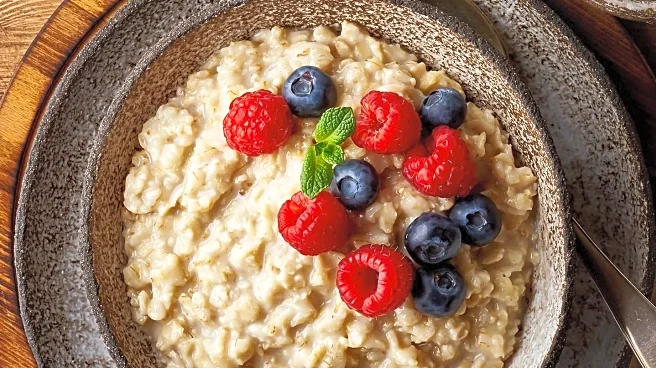What's Happening?
Recent discussions have emerged regarding the recommended daily intake of fruits and vegetables, with celebrity chef Jamie Oliver challenging the long-standing 'five-a-day' guideline. Oliver argues that significant health benefits are realized at higher consumption levels, such as seven, eight, or even eleven portions daily. This perspective is supported by research indicating that increased fruit and vegetable intake correlates with improved health outcomes, including reduced risks of chronic diseases like cardiovascular disease and cancer. The 'five-a-day' guideline, introduced over two decades ago, was intended as a practical target rather than an optimal goal. Studies suggest that consuming up to ten portions daily offers the greatest health benefits, prompting calls for revising public health messages to encourage higher consumption.
Why It's Important?
The debate over fruit and vegetable intake is significant as it impacts public health strategies aimed at reducing chronic disease prevalence. Higher consumption levels are associated with lower risks of heart disease and longer life expectancy, as evidenced by dietary patterns in Japan and Mediterranean countries. Revising guidelines to promote increased intake could lead to substantial health improvements across populations, potentially reducing healthcare costs and improving quality of life. Encouraging a diverse and abundant intake of fruits and vegetables may also foster better dietary habits and contribute to overall well-being.
What's Next?
Public health authorities may consider updating dietary guidelines to reflect the benefits of higher fruit and vegetable consumption. This could involve educational campaigns to inform the public about portion sizes and the inclusion of various forms of produce, such as frozen or tinned options. Stakeholders, including healthcare providers and nutritionists, might advocate for policy changes to support these recommendations, potentially influencing food industry practices and consumer behavior.
Beyond the Headlines
The discussion around fruit and vegetable intake highlights broader issues in public health messaging and the balance between scientific evidence and practical recommendations. It underscores the need for ongoing research and adaptation of guidelines to reflect current understanding of nutrition and health. Additionally, it raises questions about accessibility and affordability of fresh produce, which are critical factors in achieving higher consumption levels across different socioeconomic groups.











